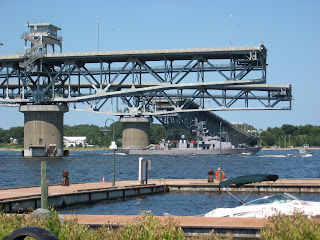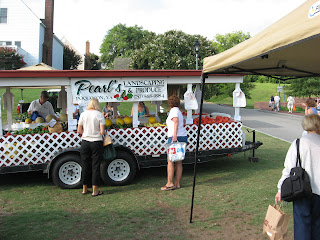We are in Tilghman MD. Say more about that later.
I finally figured out how to move pictures taken by Cona with her I-Phone to the computer. Following are a few pictures we missed posting. This is the Boddie (pronounced body) light house on the Outer Banks of NC.
Picture looking over the bow of Miss Ellen in the Urbanna harbor.
Rudy sitting at the bar in the restaurant where we were when the earth quake occured.
Where Cona put Rudy while she shoped in Williamsburg.
Rudy discussing politics with Thomas Jefferson. Rudy disagreed with Tom on several subjects.
While docked in Yorktown one of the ball fenders came loose. When we returned to the boat we saw the fender floating down the river. No problem, get in the dinghy and go get it. Right. Well, Rudy had locked the dinghy and the lock had rusted shut. Next try to cut the cable. Right. Well, the cable was hardend steel, and the cable cutter would not cut it into. Mean while the fender is floating farther down the river. Never fear we will get the cable cut or else. Try the hack saw. After cutting each stran of the cable one at a time, success, the cable was cut. Now, get in the dinghy and start the motor and go get the fender. Right. The motor started then quit. Would not start again. No problem, get out the oars. Half way to the fender a friendly boater offer help. Got the fender and pulled Rudy back to the dock. Saved one fender.
The mooring bay at Annapolis.
While in Annapolis Cona's good friends Carolyn, and Jeannie joined us for the weekend. We had a great time with them and wished they could have spent more time with us.
We were docked at the city dock which was a first come first serve dock. This was a prime spot and we did not want to loose our slip. At the same time, we wanted to tour the bay at Annapolis, so we cranked up the dinghy and took off. However, Rudy would not listen to Cona who felt Rudy should fill the motor with gas. Rudy, knowing the nissian motor didn't use much gas and the tank was half full ignored Cona.
Half way up the Spa Creek we ran out of gas.
Jeannie was good sport, got out the paddles and began paddling.
Luck with us a friendly boater came to the rescue and gave us some gas.
We were docked across from the popular dock bar, Pussers. The dock is packed ever night and there was music that we could enjoy from the bow of Miss Ellen. We didn't want to loose our dock slip. If we had pulled out anyone could take it even if you had already paid for it. That's the government run dock for you.
Left Annapolis Friday September 9 and headed to St Michales. This is a major light house we rounded as we left the bay and headed up the Miles River.
St. Michaels is a beautiful town with many shop and old homes. It is know for fooling the British who were coming up the bay bombarding each town. The town went to higher ground and hung lanterns from trees. Then, the town tuned out all light in the town. The British fired on the town aiming higher than the town aiming for the lights. All they hit were trees except one cannon ball entered the roof of a house. The ball went through the roof and rolled down the stairs and out the front door. The house survived and is currently lived in.
We were docked at a fixed dock and the distance from the dock to the boat was high so we had to use a ladder to get on and off.
While here they had a sail boat regetta. This was one of the committee boats. A lot of fun.
This is a picture of one of the sail boats used in the race. They are log boats that in the 1500 were used for harvesting oysters, clams and for fishing. The orginally were made of logs shaped to form the hull. They have no keel and use dager boards on each side to stablize the boat.
Replica of Cpt. John Smiths' sailboat he used to navigate Cheseapeake Bay.
St. Michaels has a great Waterman's museum. Rudy at one of the displays.
There is a boat building shop and volenteers may come and help build boats. This is a picture of one they are working on.
A historic lights house that was moved to the museum inorder to save it. There used to be over 100 of these on the Bay. Theres only 3 left.
Part of the museum.
Looking over the St. Michaels' harbor from the light house.
Picture of a push boat that is pulled behind the sailing boat that is used for oystering when the winds are down. The law changed requiring those harvesting oysters to not do so while using motors, they had to use sails. The watermen began using push boats to positon the sailboat over the beds they wished to harvest. The push boat was was pulled out of the water when gathering the oysters.
The log boats had large crews. To keep the boat from healing over they positioned crew on the planks.
Cona in her new bathing suit.
Rudy with the clubs commadores.
Rudy with working watermen.
That's a gun on the bow of this boat. The gun would kill 10 to 15 ducks at once. The gun was later outlawed.
Cona trying her hand at oystering with a rake.
Christ Church, St. Michael's Parish in St. Michaels. We attended service.
You can see the date this church was founded. 1672.
Pictures of some of the historic homes in St. Michaels.
Can you belive the size of this home? People live here.
Dick Channey's fishing boat.
The locals said he frequents the island to go fishing.

The sailing race of the log boats.
Cona finishes another puzzle.
We left St. Michaels and headed for Tilghman island. This is the town. This is a true waterman town. All they do here is fish and gather shell fish.
This is the marina where we stayed on the island. Our first night here we had sustanined winds of 12 MPH gusting to 30 MPH. Pretty rocky night.
The marina choir out side our boat.
We may be off the bay at some of the off bay towns for a while because the bay is full of debri as a result to tropical storm Lee. The rivers and flooded the bay and the bay is so full of trash that we are afraid to try to cross in fear of damaging Miss Ellen. This flood has caused many concerns for the oyster and clam beds as well as it will possibly distroy the crab population. This is really sad. The bay has turned from clear water to muddy water. Full of logs, refridgers, tires, everything you can think of.































































































